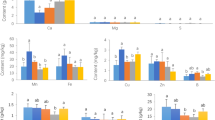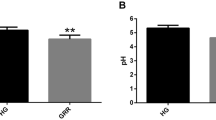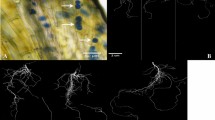Abstract
Demand is increasing for mountain-cultivatedPanax ginseng (MCG) because its quality is considered superior to that of field-cultivated ginseng (FCG). However, MCG grows very slowly, and the factors that might affect this are unknown. In addition, little information is available about the physiological characteristics of its roots. Here, we investigated local soil environments and compared the histological and chemical properties of MCG and FCG roots. Average diameters, lengths, and fresh weights were much smaller in the former. Photosynthesis rates and root cambial activity also were reduced in the MCG tissues. Our analysis of soil from the mountain site revealed an extremely low phosphorus content, although those samples were richer in total nitrogen and organic matter than were the field soils. MCG roots also contained higher amounts of ginsenosides, and total accumulations increased with age. Moreover, ginsenoside Rh2, a red ginseng-specific compound, accumulated in the MCG roots but not in those from FCG plants. Interestingly, numerous calcium oxalate crystals were found in MCG roots, particularly in their rhizomes (i.e., short stems). Therefore, we can conclude from these results that low levels of the essential mineral phosphorus in mountain soils are a critical factor that retards the growth of mountain ginseng. Likewise, the high accumulation of calcium oxalate crystals in MCG roots might be an adaptation mechanism for survival in such a harsh local environment.
Similar content being viewed by others
Literature Cited
Ando T, Tanaka O, Shibata S (1971) Chemical studies on the oriental plant drugs: XXV. Comparative studies on the saponins and sapogenins of ginseng and related crude drugs. Syoyakugaku Zasshi25: 28–32
Arnott HJ (1983) Three systems of biomineralization in plants with comments on the associated organic matrix,In CH Nancollas, ed, Biological Mineralization and Demineralization. Springer Verlag, Berlin, pp 199–218
Bel’chikova NP (1954) Determination of soil humus content by Tyurin’s method,In Agrochemical Methods of Soil Analysis, Ed 2. Russian Academy of Science, Moscow, pp 35–42
Borchert R (1985) Calcium-induced pattern of calcium oxalate crystals in isolated leaflets of Gleditsiatriacanthos L. and Alfaiziajulibrissin Durazz. Planta168: 571–578
Catt JA, Chambers BJ, Farina R, Harris GL, Hodgkinson R, Howse KR, Quintan JN (1998) Phosphorus losses from arable land in England. Soil Use Manage14: 168–174
Chang MS, Yoo BS, Byun SY (2003) Characterization of polyacetylene contents in wild mountain ginseng and cultured ginseng. Kor J Biotechnol Bioengr18: 440–442
Choi YE, Harada E (2005) Roles of calcium and cadmium on Cdcontaining intra- and extracellular formation of Ca crystals in tobacco. J Plant Biol48: 113–119
Coleman CI, Hebert JH, Reddy P (2003) The effects of Panaxginseng on quality of life. J Clin Pharm Ther28: 5–15
Constant KM, Sheldrick WF (199) An outlook for fertilizer demand, supply, and trade, 1988/89-1993/94, World Bank Technical Paper No. 137. World Bank, Washington DC
Cox MS (2001) The Lancaster soil test method as an alternative to the Mehlich 3 soil test method. Soil Sci166: 484–489
Cramer RN, Kriedemann PE, Sands PJ, Stewart LC (1993) Leaf growth and photosynthetic response to nitrogen and phosphorus in seedling trees ofCamelia arborea. Aust J Plant Physiol20: 83–98
Ellis JM, Reddy P (2002) Effects of Panaxginseng on quality of life. Ann Pharmacother36: 375–379
Franceschi VR, Homer HT (1980) Calcium oxalate crystals in plants. Bot Rev46: 361–427
Frank E (1972) The formation of crystal idioblasts inCanavalia ensiformis DC at different levels of calcium supply. Z Pflanzen-physiol67: 350–358
Fujikawa-Yamamoto K, Ota T, Odashima S, Abe H, Arichi S (1987) Different responses in the cell cycle of tumor cells to ginsenoside Rh2. Cancer J1: 349–352
Hudgins JW, Krekling T, Franceschi VR (2003) Distribution of calcium oxalate crystals in the secondary phloem of conifers: A constitutive mechanism? New Phytol159: 677–690
Huffaker RC, Wallace A (1959) Variation in root cation-exchange capacity within plant species. Agronom J51: 118
Jackson ML (1962) Soil Chemical Analysis. Constable, London
Jacob J, Lawlor DW (1991) Stomatal and mesophyll limitations of photosynthesis in phosphate deficient sunflower, maize and wheat plants. J Exp Bot42: 1003–1011
Jönsson U, Rosengren U, Thelin G, Nihlgård B (2003) Acidification-induced chemical changes in coniferous forest soils in southern Sweden 1988-1999. Environ Poll123: 75–83
Kirschbaum MUF, Tompkins D (1990) Photosynthetic responses to phosphorus nutrition inEucalyptus grandis seedlings. Aust J Plant Physiol17: 527–535
Molano-Flores B (2001) Herbivory and calcium concentrations affect calcium oxalate crystal formation in leaves ofSida (Malvaceae). Ann Bot88: 387–391
Ota T, Maeda M, Odashima S, Ninomiya-Tsuji J, Tatsuka M (1997) G1 phase-specific suppression of the Cdk2 activity by ginsenoside Rh2 in cultured murine cells. Life Sci60: PL39-PL44
Rao IM, Terry N (1989) Leaf phosphate status and photosynthesisin vivo in sugar beet: I. Changes in growth, photosynthesis and Calvin cycle enzymes. Plant Physiol90: 814–819
Rodrfguez D, Zubillaga MM, Ploschuk EL, Keltjens WG, Goudriaan J, Lavado RS (1998) Leaf area expansion and assimilate production in sunflower (Helianthus annuus L.) growing under low phosphorus conditions. Plant Soil202: 133–147
Ruiz N, Ward D, Saltz D (2002) Calcium oxalate crystals in leaves ofPancratium sickenbergeri: Constitutive or induced defence? Funt Ecol16: 99–105
Sarret G, Harada E, Choi YE, Isaure M, Geoffroy N, Fakra S, Marcus MA, Birschwilks M, Clemens S, Manceau A (2006) Trichomes of tobacco excrete zinc as zinc-substituted calcium carbonate and other zinc-containing compounds. Plant Physiol141: 1021–1034
Sharpley AN, Smith SJ, Jones OR, Berg WA, Coleman GA (1992) The transport of bioavailable phosphorus in agricultural runoff. J Environ Qual21: 30–35
Shibata S (2001) Chemistry and cancer preventing activity of ginseng saponins and some related terpenoid compounds. J Kor Med Sci16: S28–37
Urban O (2004) Physiological impacts of elevated CO2 concentration ranging from molecular to whole plant responses. Photosynthetica41: 9–20
Vogler BK, Pittler MH, Ernst E (1999) The efficacy of ginseng: A systematic review of randomized clinical trials. Eur J Clin Pharmacol55: 567–575
Ward D, Spiegel M, Sato D (1997) Gazelle herbivory and interpopulation differences in calcium oxalate content of leaves of a desert lily. J Chem Ecol23: 333–346
Webb MR, Cavaletto JM, Carpita NC, Lopez LE, Arnott HJ (1995) The intravacuolar organic matrix associated with calcium oxalate crystals in leaves ofVitis. Plant J7: 633–648
Yeung EC (1999) The use of histology in the study of plant tissue culture systems-some practical comments. In Vitro Cell Dev Biol35: 137–143
Author information
Authors and Affiliations
Corresponding author
Rights and permissions
About this article
Cite this article
Choi, Y.E., Kim, Y.S., Yi, M.J. et al. Physiological and chemical characteristics of field-and mountain-cultivated ginseng roots. J. Plant Biol. 50, 198–205 (2007). https://doi.org/10.1007/BF03030630
Received:
Accepted:
Issue Date:
DOI: https://doi.org/10.1007/BF03030630




